An Introduction to the Artist
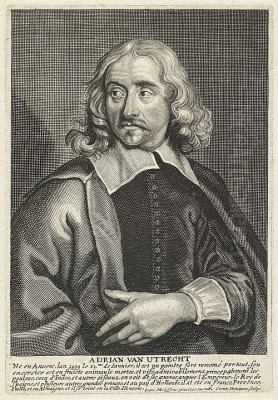
Adriaen van Utrecht (1599–1652) stands as a significant figure in the rich tapestry of Flemish Baroque painting. Born in Antwerp, a bustling hub of artistic innovation during the 17th century, Van Utrecht carved a distinct niche for himself as a master of still life. His canvases burst with life, showcasing opulent arrangements of food, game, fruit, and luxurious objects, rendered with remarkable detail and vibrant colour. He was particularly celebrated for his grand banquet scenes, market stalls, and kitchen interiors, which captured both the abundance of nature and the material wealth of the era.
Van Utrecht's work is characterized by its dynamic compositions, dramatic use of light and shadow (chiaroscuro), and an almost tactile rendering of textures. From the glistening scales of fish to the soft down of birds and the reflective sheen of metalware, his technical prowess was undeniable. While firmly rooted in the Flemish tradition, his art also reveals influences absorbed during his travels, blending local sensibilities with broader European Baroque trends. He emerged not just as a painter of beautiful objects, but as an artist who could orchestrate complex scenes brimming with energy and visual delight, securing his place among the leading still-life painters of his time.
Early Life and Artistic Formation in Antwerp
Adriaen van Utrecht was born into a prosperous family in Antwerp in 1599. The city itself was a crucible of artistic talent, home to giants like Peter Paul Rubens and Anthony van Dyck. This environment undoubtedly provided a stimulating backdrop for a young aspiring artist. Records indicate that Van Utrecht began his formal artistic training in 1614 under Herman de Ryt, a painter and art dealer registered with the Antwerp Guild of Saint Luke. While details about de Ryt's own work are scarce, this apprenticeship provided Van Utrecht with the foundational skills in drawing and painting.
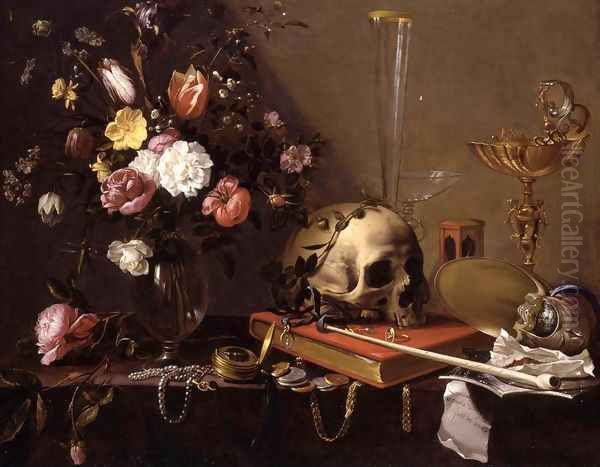
However, a more profound influence on Van Utrecht's developing style came from Frans Snyders (1579–1657), the pre-eminent Flemish painter of animals and large-scale market and hunting still lifes. Although there's no definitive proof that Van Utrecht was formally apprenticed to Snyders, the thematic and stylistic parallels between their works are unmistakable. Snyders's dynamic compositions, his masterful depiction of animals (both live and dead), and his penchant for large, crowded canvases clearly resonated with Van Utrecht, who would adapt and refine these elements in his own unique manner.
The artistic scene in Antwerp during Van Utrecht's formative years was vibrant and competitive. Artists often specialized, and still life, particularly the elaborate displays of food and game, was becoming increasingly popular among wealthy patrons. Van Utrecht absorbed these trends, learning from established masters and preparing to make his own mark within this flourishing artistic milieu. His early works likely already showed a preference for the subjects that would define his career: the bounty of the pantry, the hunt, and the market.
Travels and the Broadening of Horizons
Like many ambitious artists of his time, Adriaen van Utrecht recognized the value of travel for expanding his artistic knowledge and experience. After completing his initial training in Antwerp, he embarked on journeys that took him through France, Germany, and, significantly, Italy. These travels, likely undertaken in the early 1620s before he became a master in the Antwerp Guild, were crucial for his artistic development. Exposure to different artistic traditions, landscapes, and cultures inevitably enriched his visual vocabulary.
In Italy, the cradle of the Renaissance and the burgeoning Baroque, Van Utrecht would have encountered firsthand the works of Italian masters. The dramatic intensity and powerful use of chiaroscuro pioneered by Caravaggio (1571–1610) and his followers were transforming painting across Europe. While Van Utrecht remained fundamentally a Flemish painter, the heightened sense of drama, the strong contrasts between light and shadow, and the rich, often warmer colour palettes seen in his mature work likely owe a debt to his Italian sojourn.
His travels through France and Germany would also have exposed him to different schools of still life and genre painting. This period abroad allowed him to observe, sketch, and absorb diverse influences, refining his technique and broadening his thematic range. Upon his return to Antwerp, he brought back not just memories and sketches, but a more cosmopolitan artistic perspective, ready to synthesize these experiences with his Flemish roots. This combination of local tradition and international awareness contributed significantly to the distinctive quality of his art.
Mastership and Mature Style in Antwerp
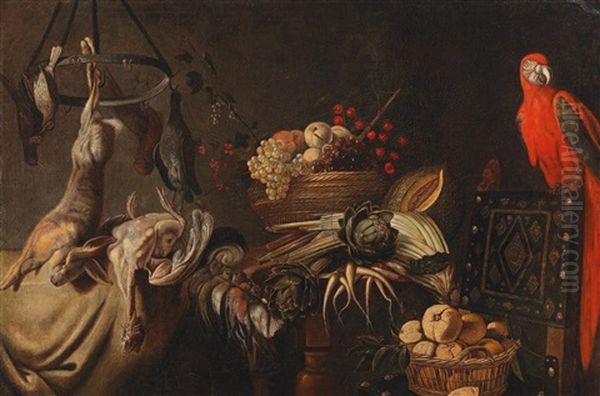
In 1625, Adriaen van Utrecht was officially registered as a master in the prestigious Guild of Saint Luke in Antwerp. This marked his formal recognition as an independent artist, allowing him to establish his own workshop, take on pupils, and sell his works freely. He quickly gained renown for his particular specializations within the still-life genre. His workshop became a productive centre, meeting the growing demand for decorative and sumptuous paintings among the affluent bourgeoisie and aristocracy.
His mature style solidified during this period. Van Utrecht became synonymous with large-scale, elaborate still lifes often referred to as pronkstilleven (ostentatious or sumptuous still lifes). These works celebrated abundance, featuring tables laden with gleaming silverware, imported fruits like lemons and oranges, expensive shellfish such as lobsters, game birds, vegetables, and fine glassware. His compositions were typically dynamic, often using diagonal lines and a careful arrangement of objects to create a sense of depth and movement, preventing the potentially static subject matter from becoming dull.
A hallmark of Van Utrecht's style is his extraordinary ability to render textures convincingly. The rough skin of a lemon, the smooth, cool surface of a pewter plate, the intricate patterns on a carpet, the soft fur of a rabbit – all were depicted with meticulous attention to detail. He combined this precision with a rich and often warm colour palette, employing deep reds, greens, and ochres, frequently set against darker backgrounds to enhance the luminosity of the principal objects through strong chiaroscuro, a technique likely refined during his travels.
A Cornucopia on Canvas: Subjects and Themes
Adriaen van Utrecht's oeuvre encompasses a range of still-life subjects, though he is best known for his depictions of abundance related to food and the hunt.
Pronkstilleven: The Lavish Display
The pronkstilleven was Van Utrecht's forte. These paintings were designed to impress, showcasing the wealth and sophisticated tastes of their owners. They often feature a luxurious disarray of items on a draped table: overflowing fruit bowls, platters of oysters and lobster, dead game birds (pheasants, partridges), ornate vessels, and sometimes exotic elements like parrots or monkeys. These compositions are complex, multi-layered visual feasts that invite the viewer to marvel at both the depicted riches and the artist's skill.
Market and Kitchen Scenes
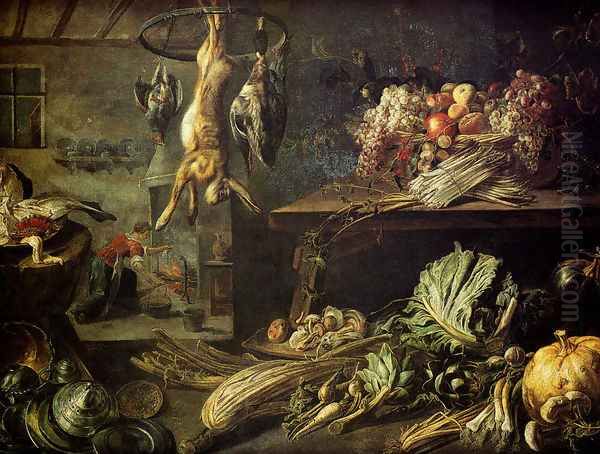
Van Utrecht frequently painted bustling market stalls and well-stocked kitchen interiors. These scenes allowed him to combine still-life elements with genre aspects, sometimes including figures (often painted by collaborators like Jacob Jordaens or David Teniers the Younger). A typical kitchen scene might show a maid preparing food amidst a profusion of vegetables, dead game, fish, and kitchen utensils. These works offer a glimpse into the domestic world, albeit an idealized and abundant one, rendered with the same richness and detail as his more formal banquet pieces.
Game Pieces and Hunting Trophies
Following in the footsteps of Frans Snyders, Van Utrecht excelled at painting game pieces – arrangements featuring the results of the hunt. Dead hares, deer, wild boar, and various birds are depicted with anatomical accuracy and a remarkable feel for the texture of fur and feathers. These paintings often carry connotations of aristocratic pursuits and the bounty of nature, serving as impressive decorative pieces for dining halls or studies. His skill in this area was such that his work was sometimes mistaken for that of Snyders.
Fruit, Flowers, and Animals
While less dominant than his banquet and game scenes, Van Utrecht also painted compositions focusing purely on fruit or incorporating floral elements, sometimes in the form of garlands. More significantly, animals frequently populate his canvases. Live parrots, often brightly coloured cockatoos, perch on stands or objects, adding an exotic touch. Monkeys, traditional symbols of base instincts or folly, might be shown mischievously interacting with the food. Dogs, usually hunting breeds, often appear in his game pieces or kitchen scenes, adding a sense of life and narrative potential to the arrangements.
Vanitas Elements
Though primarily known for celebrating earthly abundance, Van Utrecht occasionally incorporated vanitas themes into his work, reminding the viewer of the transience of life and the fleeting nature of worldly pleasures. His painting Vanitas—Still Life with Bouquet and Skull is a prime example. Here, the typical elements of luxury (flowers, perhaps a watch or musical instrument, though the title emphasizes the bouquet and skull) are juxtaposed with a human skull, a direct symbol of mortality. This reflects a common preoccupation in Baroque art and culture, adding a layer of moral or philosophical depth to the visual display.
Masterworks in Focus
Several key works exemplify Adriaen van Utrecht's skill and artistic vision.
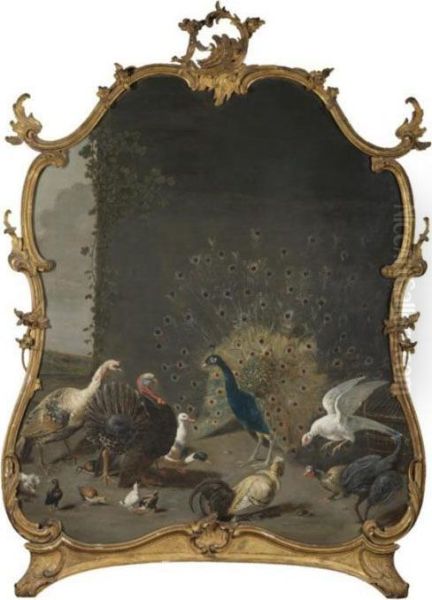
One of his most famous and representative paintings is Still Life with Game, Vegetables, Fruit, and a Parrot, housed in the Museo del Prado, Madrid (though similar compositions exist elsewhere, like the Rijksmuseum). This large canvas is a quintessential example of his pronkstilleven. It presents a staggering array of objects: dead game birds hang prominently, a large basket overflows with fruits and vegetables, a lobster adds a splash of vibrant red, and an artichoke sits near cabbages and root vegetables. A live parrot surveys the scene, adding an exotic touch. The textures are brilliantly rendered, from the feathers of the birds to the rough skin of the melon, all bathed in a dramatic light that highlights the central elements against a darker background. The composition is complex yet balanced, a testament to Van Utrecht's ability to orchestrate such visual abundance.
His Kitchen Interior paintings, often created in collaboration with figure painters, showcase another facet of his work. A notable example, possibly involving Jacob Jordaens for the figures, might depict a kitchen maid surrounded by a wealth of produce. Copper pots gleam, vegetables spill from baskets, fish lie on a table, and game hangs nearby. These scenes blend still life with genre painting, offering a lively, albeit idealized, view of domestic activity, emphasizing plenty and productivity. The meticulous rendering of each object remains paramount.
The Vanitas—Still Life with Bouquet and Skull (National Museum, Warsaw) offers a contrast to the purely celebratory works. While still showcasing his skill in depicting flowers with delicate beauty, the prominent skull shifts the meaning. It serves as a memento mori, urging contemplation on mortality amidst the beauty and richness of life. The juxtaposition is stark and follows a well-established tradition in Netherlandish art, demonstrating Van Utrecht's engagement with deeper symbolic themes beyond mere representation.
Another type of work highlighting his precision is exemplified by paintings sometimes titled Various Birds or similar. These compositions often feature detailed studies of different bird species, showcasing his keen observation skills and ability to capture the unique plumage and characteristics of each creature with almost scientific accuracy, yet arranged with artistic sensibility.
A Network of Artists: Collaborations and Influence
Adriaen van Utrecht operated within a dynamic network of artists in Antwerp and beyond. His career was shaped by influences, rivalries, and collaborations that were common in the 17th-century art world.
The Enduring Influence of Frans Snyders
The most significant artistic relationship for Van Utrecht was arguably with Frans Snyders. While Van Utrecht developed his own distinct style, characterized perhaps by a slightly softer touch and warmer palette compared to Snyders's often cooler tones, the debt is undeniable. Both specialized in large-scale market scenes, pantry interiors, and game pieces. They were the leading masters in this field in Antwerp after Snyders rose to prominence, and their works were sometimes confused, as evidenced by the initial attribution of Van Utrecht's work for Buckingham Palace to Snyders.
Working with Figure Painters
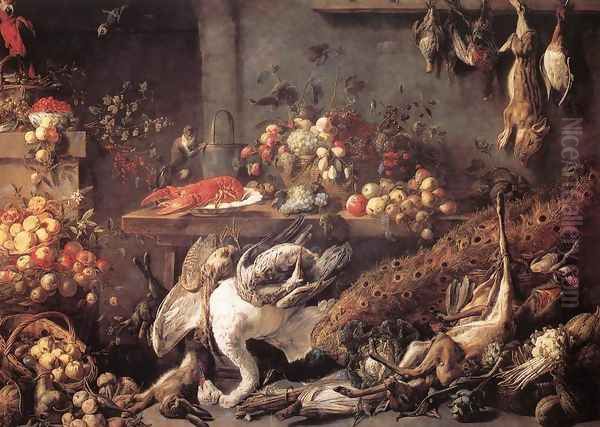
Still-life painters often collaborated with artists who specialized in figures to add narrative elements or human presence to their scenes. Van Utrecht is known to have collaborated with several prominent Antwerp painters. His most frequent collaborator was likely Jacob Jordaens (1593–1678), a leading figure alongside Rubens. A joint work from 1637, a kitchen scene, is documented. He also collaborated with David Teniers the Younger (1610–1690), another master of genre scenes. Other collaborators included Erasmus Quellinus II (1607–1678), Theodoor Rombouts (1597–1637), and Thomas Willeboirts Bosschaert (1613–1654), demonstrating his integration into the highest levels of Antwerp's artistic production. These collaborations allowed him to create more complex and marketable compositions.
Dialogue with Jan Davidsz. de Heem
Van Utrecht's work also seems to have influenced other major still-life painters. There appears to have been a dialogue between Van Utrecht and Jan Davidsz. de Heem (1606–1684), who arrived in Antwerp around 1635/36. De Heem became famous for his incredibly detailed and luxurious pronkstilleven. Art historians suggest that Van Utrecht's opulent compositions from the early 1640s, such as a notable 1642 piece featuring a prominent red lobster, may have spurred De Heem towards the even more elaborate style that would become his trademark. This indicates mutual awareness and potentially competitive artistic exchange.
Other Connections
Van Utrecht's life intersected with other artists in various ways. In 1636, he and the genre painter Adriaen Brouwer (1605/6–1638) acted as witnesses for the painter Jan Lievens (1607–1674), suggesting collegial relationships within the Antwerp art community. His own family included artists; his brother was the famous peasant genre painter Adriaen van Ostade (1610–1685), although they worked in very different fields. His sister Catharina married Cornelis Dusart, who later took over Van Ostade's workshop. He was also connected through marriage to Jan van Kessel the Elder (1626-1679), a painter known for his detailed studies of insects and flowers, who married Van Utrecht's sister Catarina. While RKD primarily lists Philip Gyselaer as his pupil, these family and professional ties illustrate the interconnected nature of the art world. He was also a contemporary of Jan Fyt (1611–1661), another important Antwerp painter specializing in animals and game.
Recognition, Patronage, and Reputation
Adriaen van Utrecht achieved considerable success and recognition during his lifetime, both locally and internationally. His acceptance as a master in the Guild of Saint Luke in 1625 was the first step towards establishing a professional reputation. His skill in creating large, decorative, and visually impressive still lifes perfectly matched the tastes of the wealthy merchant class in Antwerp and the aristocracy across Europe.
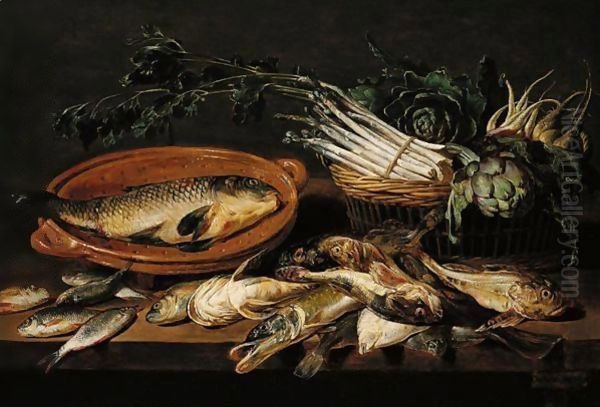
His patrons included some of the most powerful figures of the era. Notably, he received commissions from the Spanish court, working for King Philip IV of Spain, a renowned collector and patron of the arts. This connection highlights his international standing, as Spanish patronage was highly sought after by Flemish artists. He also worked for the Dutch Stadtholder, likely Frederick Henry, Prince of Orange, or his successor, contributing works to the princely collections in The Hague. Evidence suggests he may have been involved in the decorations for Huis ten Bosch, a royal palace near The Hague, a project that involved many leading artists.
His reputation extended to England as well. Works by him entered English collections, although, as mentioned earlier, some were initially misattributed to Frans Snyders, indicating that while Snyders might have had the greater name recognition initially, Van Utrecht's quality was comparable. The eventual correct attribution of works like those for the Duke of Buckingham demonstrates the growing appreciation for his specific talents. The demand for his paintings remained strong throughout his career, allowing him to maintain a successful workshop in Antwerp.
The Workshop, Legacy, and Influence
Like most successful artists of his time, Adriaen van Utrecht likely maintained an active workshop with assistants and possibly pupils to help meet the demand for his paintings. While only Philip Gyselaer (active 1640s-50s) is securely documented by major sources like the RKD as a pupil, the scale and consistency of his output suggest workshop participation. It's also plausible that high-quality replicas or variations of his most popular compositions were produced under his supervision, a common practice to maximize income and disseminate his style.
Van Utrecht's primary legacy lies in his contribution to the development and popularization of the Flemish Baroque still life, particularly the pronkstilleven. Alongside Frans Snyders, he defined the genre of large-scale, opulent displays of food, game, and luxurious objects. His work is characterized by its vibrant energy, masterful rendering of textures, and complex, dynamic compositions. He successfully blended the detailed realism inherited from earlier Netherlandish traditions with the dramatic flair and richness of the international Baroque style.
His influence can be seen in the work of subsequent still-life painters. As noted, he likely played a role in the evolution of Jan Davidsz. de Heem's style towards grander compositions after De Heem's arrival in Antwerp. Through his numerous works distributed across Europe, Van Utrecht helped to solidify the reputation of Antwerp as a leading centre for still-life painting. His paintings continue to be admired in major museums worldwide for their technical brilliance and their captivating depiction of 17th-century material culture and the sheer joy of visual abundance.
Final Flourish: The Enduring Appeal of Van Utrecht
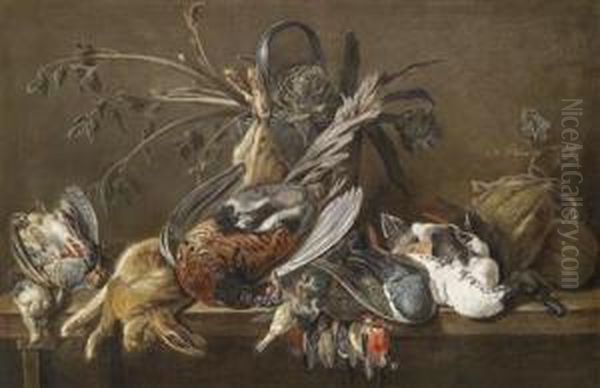
Adriaen van Utrecht died in Antwerp in 1652, leaving behind a substantial body of work that continues to fascinate viewers today. His paintings are more than just meticulous depictions of objects; they are carefully orchestrated celebrations of texture, colour, and light. They capture the spirit of the Baroque era – its energy, its love of drama, and its appreciation for both natural bounty and human craftsmanship.
His ability to imbue static objects with a sense of life and movement, his skill in rendering diverse materials with convincing realism, and his mastery of complex compositions ensure his place as a key figure in the history of European still life. Whether depicting a lavish banquet table, a bustling kitchen, or the spoils of a hunt, Van Utrecht's canvases offer a window onto the world of 17th-century Flanders, presented with an artistic flair that transcends mere documentation. His work remains a testament to the enduring power of still life painting to engage the senses and delight the eye.